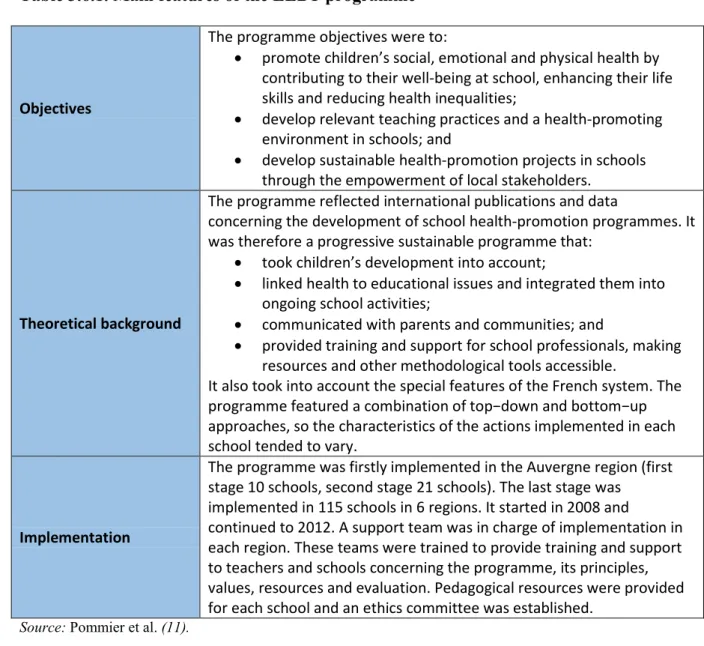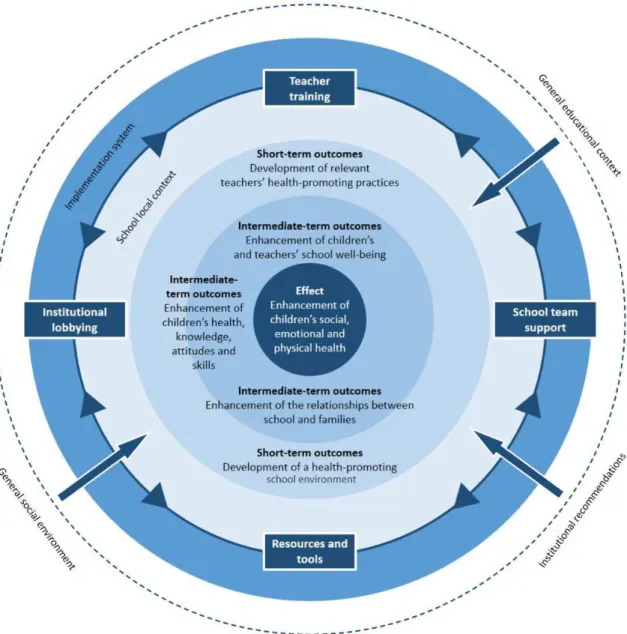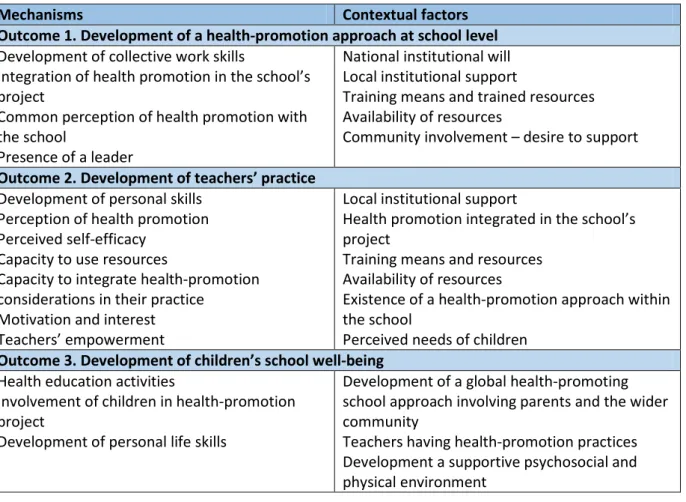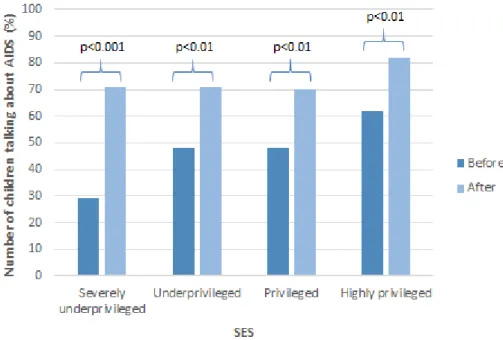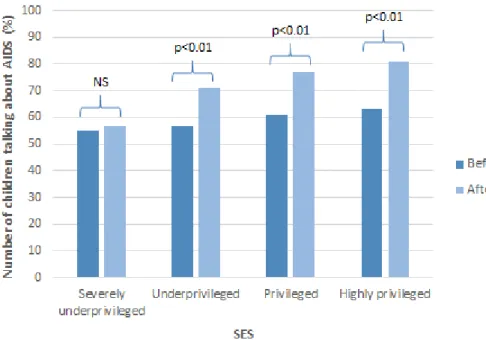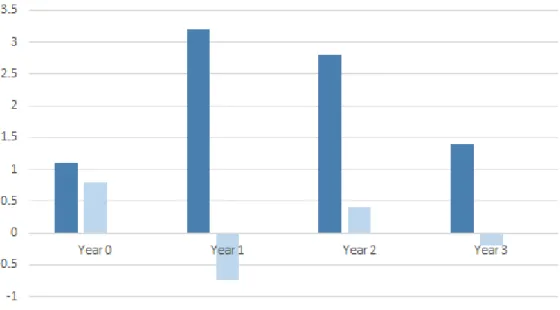HAL Id: hal-01063827
https://hal.archives-ouvertes.fr/hal-01063827
Submitted on 15 Sep 2014HAL is a multi-disciplinary open access archive for the deposit and dissemination of sci-entific research documents, whether they are pub-lished or not. The documents may come from teaching and research institutions in France or abroad, or from public or private research centers.
L’archive ouverte pluridisciplinaire HAL, est destinée au dépôt et à la diffusion de documents scientifiques de niveau recherche, publiés ou non, émanant des établissements d’enseignement et de recherche français ou étrangers, des laboratoires publics ou privés.
communities to implement a health promotion policy
and minimize health inequalities in France
Didier Jourdan
To cite this version:
Didier Jourdan. ”Learning to live better together”: enabling schools and communities to implement a health promotion policy and minimize health inequalities in France. 2013, pp.47-59. �hal-01063827�
47
3.6. “Learning to live better together”: enabling schools
and communities to implement a health promotion
policy and minimize health inequalities in France
Didier JourdanUniversity Blaise Pascal, Clermont-Ferrand
Context
Reducing health inequalities is an issue of fairness and social justice, and action should be focused on reducing the gradient. Giving every child the best start in life is crucial to
reducing health inequalities across the life-course (1). Family, local communities and schools have a key role to play in achieving equity from the start (2).
This case study provides an account of work taken forward in France at regional and national level through the “Learning to live better together” (LLBT) programme, the aim of which was to develop sustainable health-promotion projects in school settings by empowering local stakeholders. LLBT was a health-promotion programme adapted to the French education context and was developed in three stages commencing 1998. The last stage (2008−2012) involved 115 primary schools in 6 regions, involving 650 teachers and 12 000 children and their families. Most resources for teacher training and implementation of health-promotion programmes in schools produced at national level by INPES (3) and the network of French teacher education colleges for health education and health promotion (4) are based on the LLBT programme.
Schools’ contribution to students’ health and well-being is increasingly recognized (5). Evidence shows that a whole-school approach to health education (in which school practice reflects school policy) promotes a sense of belonging and openness within educational experiences, resulting in improved learning, increased emotional well-being and reduced risk behaviours (6). Essentially, schools are most effective in health promotion when actively engaged in promoting health among students, staff, families and community members (7). The broad concept of the health-promoting school emerged from this evidence, but only a few studies on health promotion in the school setting have analysed differential effects across socioeconomic groups or the effects of specific programmes for disadvantaged groups. There is currently no evidence in the literature on the contribution of the health-promoting school approach to reducing health inequalities. This explains why one of the objectives of the LLBT project was to assess differential effects across socioeconomic groups and why data from the project have been stratified by the SES of schools.
Provision and services for children
Early years
Mothers and babies are closely monitored and cared for during pregnancy and in the months immediately following birth by a specialist team of professional health care providers who implement preventive (mostly parental support) and curative measures. The key health care providers are GPs and specialist physicians, the mother and child protection service and hospital neonatal and paediatric departments (8).
48
Schools
Specific health personnel (nurses and doctors) are deployed in schools. Health education is not taught as a separate subject, but as a part of citizenship education. It does not, therefore, require specialist teachers, but is part of the everyday activity of all school staff and is focused on developing students’ ability to make informed and responsible decisions. Government guidance on health education in schools and colleges (9) states:
Unlike conditioning, health education aims to help young people gradually build personal capacity in terms of making decisions and adopting responsible behaviour for themselves and with respect to other people and the environment. It also makes it possible to prepare young people for playing a responsible role in society where health matters are of major concern.
Schools have been able to access an additional resource, the Health and Citizenship
Education Committee, since the early 1990s. The committee provides a coherent articulation of school health policy from a health-promotion perspective and aims to “bring together prevention actions, mobilize those involved in the education community, strengthen links with other services [and] improve the climate and relations within schools” (10).
M ajor health issues
Life expectancy in France at age 65 is one of the highest in Europe but is significantly lower for men at 16 and 20. There are also major differentials between regions and socially based inequalities in health remain a priority. Inequality and premature mortality (death before 65 years) remain important areas for improvement (9).
Approach
The health-promotion intervention (11)was developed to address health issues within school settings and to give school staff the means to implement a relevant health-promotion policy whatever the socioeconomic context of the school (12). It aimed to promote children’s social, emotional and physical health by contributing to their well-being at school and enhancing their life skills. The objective was to develop sustainable health-promotion projects in primary schools through empowerment of local stakeholders. The main strategy, which was based on relevant international data (5,13), was to develop teachers’ health-promoting practices and schools’ health-promoting environments.
Professional development was offered to teachers by support services to ensure health promotion was included in the everyday life of the school. This included teacher education, school team support, resources, tools and institutional lobbying. Support-service development officers were backed by the department of teacher training of the Institut Universitaire de Formation des Maîtres [University Institute of Teacher Training]. The initiative was based on evidence suggesting that education can positively influence teachers’ practice (14) and schools’ health-promoting environments, enhance the well-being of children and teachers at school, improve the relationship between schools and families (15), develop children’s health knowledge, attitudes and skills, and possibly improve children’s social, emotional and
physical health (16).
Three types of evidence were used to develop the intervention: scientific,
“professional”−contextual, and “critical”. The evidence was embedded within the programme through the training and support process.
49
The training process included the development of health education activities within the existing curriculum (French, science, arts, physical education, etc.) with a special emphasis on oral and written expression in the mother tongue (using recommended children’s literature from the national list). Teachers initially undertook one week of training and all teachers participated in half-day sessions three times a year over the course of the next four years. All were supplied with resources, including teaching materials and mapping and assessment tools.
School participation was on a voluntary basis, the choice to take part being made by staff after a vote. This meant that while some schools reached consensus on their decision to participate, others did so only through a majority vote. The fact that a school participated did not mean, therefore, that all teachers were willing to be involved. Schools had different teacher participation patterns, which was considered permissible out of respect for teachers’ ontological positions.
The programme was implemented in six French regions. Each had a steering committee, consisting of representatives of school boards, parents and other relevant regional
stakeholders, and a support team (teacher trainers, pedagogical advisers, members of health-promotion services and local NGOs) which was in charge of programme implementation. The six support teams, one per region, were trained to deliver training and support to teachers and schools concerning the programme, its principles, values, resources and evaluation. Pedagogical resources were provided to each school. The project was supervised by a scientific committee of health and education experts and practitioners and an ethics committee was put in place to deal with questions raised through the implementation and evaluation of the intervention.
The main features of the health-promotion programme are shown in Table 3.6.1.
LLBT, in common with other health-promotion programmes, could be defined as any activity undertaken to protect or improve the health of all school users. This means that its activities and outcomes were numerous and complex. “Health”, the ultimate goal of health promotion, cannot be achieved directly, but is attained through intermediate stages. In this sense, health promotion is understood to be a social learning process taking place at individual, group and organizational levels (17). Different outcomes then become possible: improvement in the health of a population is the desired outcome, but intermediate outcomes include changes in health determinants and change in factors influencing health determinants (18).
To understand the different factors having an influence on the implementation and outcomes of the LLBT programme, what Chen and Rossi (19) define as the “theory-driven” approach to evaluation was taken into consideration. This approach:
... is not the global conceptual scheme of the grand theorists, but more prosaic theories that are concerned with how human organizations work and how social problems are generated […]. What we are strongly advocating is the necessity for theorizing, for constructing plausible and defensible models of how programs can be expected to work before evaluating them.
50
Table 3.6.1. Main features of the LLBT programme
Objectives
The programme objectives were to:
• promote children’s social, emotional and physical health by contributing to their well-being at school, enhancing their life skills and reducing health inequalities;
• develop relevant teaching practices and a health-promoting environment in schools; and
• develop sustainable health-promotion projects in schools through the empowerment of local stakeholders.
Theoretical background
The programme reflected international publications and data
concerning the development of school health-promotion programmes. It was therefore a progressive sustainable programme that:
• took children’s development into account;
• linked health to educational issues and integrated them into ongoing school activities;
• communicated with parents and communities; and
• provided training and support for school professionals, making resources and other methodological tools accessible.
It also took into account the special features of the French system. The programme featured a combination of top−down and bottom−up approaches, so the characteristics of the actions implemented in each school tended to vary.
Implementation
The programme was firstly implemented in the Auvergne region (first stage 10 schools, second stage 21 schools). The last stage was
implemented in 115 schools in 6 regions. It started in 2008 and
continued to 2012. A support team was in charge of implementation in each region. These teams were trained to provide training and support to teachers and schools concerning the programme, its principles, values, resources and evaluation. Pedagogical resources were provided for each school and an ethics committee was established.
Source: Pommier et al. (11).
This implies a need to identify theory consistent with social science knowledge and theory, which drove the development of a theory-of-change logic model to underpin the intervention. Fig. 3.6.1 suggests that strategies developed through the intervention (teacher training, school team support, resources and tools, and institutional lobbying) can positively influence
teachers’ practice and schools’ health-promoting environments to enhance children’s and teachers’ school well-being, the relationship between school and families and, eventually, children’s life skills. The model assumes that outcomes and strategies interact with contextual factors (institutional recommendations, community requests and school context) and the implementation system (rules, organizational structures and personnel who have been given responsibility for the intervention) (Table 3.6.2).
The programme assessment was based on a mixed-method approach that combined
quantitative and qualitative methods to provide a wider understanding. The literature shows that mixed-method approaches:
• provide strengths that offset the weaknesses of quantitative and qualitative research; • provide more comprehensive evidence for studying a research problem than either
51
Fig. 3.6.1. Theory-of-change model underlying the health promotion programme in school settings
Source: modified from Pommier et al. (11).
• help to answer questions that cannot be answered by qualitative or quantitative approaches alone;
• encourage researchers to collaborate;
• encourage the use of multiple worldviews or paradigms; and
• are “practical” in the sense that the researcher is free to use all methods possible to address a research problem (20).
Four questionnaires were developed for children, teachers, parents and school communities. Two forms were used to collect contextual information and semi-structured interviews were performed throughout the implementation process.
52
Table 3.6.2. Categories of general mechanisms and contextual factors that may play a role in desired outcomes
Mechanisms Contextual factors
Outcome 1. Development of a health-promotion approach at school level Development of collective work skills
Integration of health promotion in the school’s project
Common perception of health promotion with the school
Presence of a leader
National institutional will Local institutional support
Training means and trained resources Availability of resources
Community involvement – desire to support
Outcome 2. Development of teachers’ practice Development of personal skills
Perception of health promotion Perceived self-efficacy
Capacity to use resources
Capacity to integrate health-promotion considerations in their practice
Motivation and interest Teachers’ empowerment
Local institutional support
Health promotion integrated in the school’s project
Training means and resources Availability of resources
Existence of a health-promotion approach within the school
Perceived needs of children Outcome 3. Development of children’s school well-being
Health education activities
Involvement of children in health-promotion project
Development of personal life skills
Development of a global health-promoting school approach involving parents and the wider community
Teachers having health-promotion practices Development a supportive psychosocial and physical environment
Evidence
Evidence was collected in relation to health determinants (well-being in schools, communication about health and health knowledge). The key findings are as follows.
The approach proved successful in reducing social differences in som e outcom es after one year of im plem entation
Four subgroups reflecting the social environment of schools were formed in the first implementation stage (involving 10 schools and 350 children age 9-11). They were
established using criteria from the National Institute of Statistics and Economic Studies (21), which are based on the profession of the head of the family. Population A (14%) was
severely underprivileged, B (31%) was relatively underprivileged, C (30%) was privileged and D (25%) was highly privileged (22).
Before the intervention, population A (severely underprivileged) scored the “dangerousness” of AIDS less than the other subgroups (p=0.007), but there was no difference after. This was also the case concerning the way people living with AIDS were seen and in the perception of the absence of risk of infection in everyday life.
Fifty-one per cent of the children had talked about AIDS with adults before the intervention. In the second series, 76% had done so, either before the first session or between sessions one and two. The effect of the programme was all the more important as the school was
53
Fig. 3.6.2. Influence of SES on the effect of the intervention on children’s communication about AIDS with teachers
Note: ** p<0.01; ***p<0.001.
Source: modified from Berger et al. (22).
In some cases, the programme reduced differences between social groups. For example, the highly-privileged group referred to sex and sexuality more than the severely underprivileged group before the intervention (p=0.0001), but one year after implementation, the difference was not so marked (p=0.05).
The program m e had no positive effect on outcom es closely related to the environm ent or integrative variables such as school clim ate after one year
Data from the first implementation stage showed the programme had an effect on outcomes closely related to the environment (communication about AIDS in the family), but the effect differed among groups. The effect of the programme was all the more important, as the school was privileged. Social inequalities for this variable were increased by the programme after one year of implementation (Fig. 3.6.3).
The second phase of implementation (age 9−11, n=936, 21 schools) was focused on school climate. School scores in the highly-privileged group before the intervention were higher than in the underprivileged group and were more marked after a year of implementation: the increase in the highly-privileged group was 3.36 compared to 1.42 in the underprivileged, leading to an increase in inequalities. This result can be explained by the strong influence of student-related and environment-related variables in comparison to school-related variables. The multilevel model showed only 8% of the variance could be explained by variables linked to the school: the dependant variable in the model was the perceived school climate and the hierarchical analysis was made on 43 variables (Fig. 3.6.4). These data clearly show the importance of strong connections between school and the environment (23).
54
Fig. 3.6.3. Influence of SES on the effect of the intervention on communication about AIDS in the family
Note: NS: not significant; ** p<0.01; ***p<0.001. Source: modified from Berger et al. (22).
Fig. 3.6.4. Hierarchical analysis of the variance of the school climate
Source: modified from Jourdan (23).
Sustainable im plem entation is necessary
The effect of the programme was faster and more powerful if the school was in a privileged environment (Fig. 3.6.5). Three years of implementation were required to equalize the programme’s effect on schools for different socioeconomic groups (second phase, n=936).
55
Fig 3.6.5. Differences in scores on school climate between schools (three groups of schools by family SES)
Implementation
Implementation could not be considered a top−down process in which the stakeholders were simply required to do as they were instructed. The LLBT approach, resources and
management tools were adapted to reflect the stakeholders’ concerns and contextual constraints throughout the process.
The training and support process provided the main implementation strategy at national and local levels. Local stakeholders implemented the health-promotion approach differently, according to their positions, and challenged it at different levels (24).
The evidence helped teachers to adjust their pedagogical practice in some areas, such as responding to conflict in the classroom and developing children’s self-esteem. It also helped teachers to develop a global approach to health promotion that reflected collective work within the school team.
Getting involvement from parents was often difficult. Historically, parents’ roles within schools has been unclear and was only recognized officially a few years ago. Work with a research group (25) and new resources were taken forward during stage 2 to address this challenge.
The evidence helped to emphasize the need for collective practice and partnerships with local stakeholders at school-team level. Characteristics of partnerships with local stakeholders were variable within the schools (partnerships are not a common way of working within the French school system, especially at primary level). A teacher trainer who is also a researcher specializing in partnerships at school level organized a training session that addressed the difficulties of partnership implementation and potential strategies that can be developed at school level. The evidence also led school teams to take a more global perspective of children’s health that reflected all of the children’s health determinants at school. This evidence was essential to secure schools’ commitment to the programme.
56
At regional level, the evidence helped support teams to develop a transversal approach to health promotion, in addition to thematic approaches. Regional teams had participated in the tool validation process and contributed to the development of the evaluation approach, but the objectives and evaluation process were challenged during the data collection and the process had to be renegotiated to ensure not only scientific rigour, but also acceptability to local stakeholders.
Despite existing evidence and compelling arguments for school health promotion, getting teachers involved in implementing the programme remains a challenge. Teachers are currently squeezed between the social pressure to participate in health-promotion initiatives and institutional pressure to complete school programmes. It remains very difficult for teachers to clearly identify the nature of what is expected of them and what their core business actually is in the face of massive overprescription of objectives (26). Their
involvement in different modalities of the LLBT programme depended on factors specific to individual teachers (27), three of which were shown to have a significant effect on health-promoting teaching practices:
• personal interest in health promotion (odds ratio (OR) 1.97, p=0.001) • training (OR 3.74, p=0.03)
• collective work at school level (OR 2.97, p=0.05).
Involvement in the LLBT programme was classified under three main headings:
• classroom practices (specific pedagogical sequences, adaptation of certain methods): “I am working with ‘Le petit humain’7 and so on basic human needs, and I asked them at the start to write out for me what they themselves needed to feel good physically and mentally” (primary-school teacher, stage 2);
• “way of being” in the classroom (specific attention to development of personal and social skills): “Living in the community is, of course, an everyday concern, but the fact of focusing on it a little more means that I go a bit more deeply into things; I still do the classroom work as usual, but I feel I have another perspective – emphasizing certain things that I used to do more superficially up to now” (primary-school teacher, stage 2); and
• management of “living in community” at whole-school level from a health-promotion perspective: “What is important is that we actually took stock of things … last year … we realized that there were issues, for example about the toilets, that the little ones were being pestered by the older ones, and so we made changes to improve things, based on listening to the children themselves” (primary-school teacher, stage 2). Participation in LLBT therefore had individual and collective dimensions.
Conclusion
LLBT is an approach that has been implemented in the French school system for more than 12 years. It is well designed from a theoretical perspective and is being shared by more and more practitioners at national level. Numerous resources developed by INPES (28) and others are now based on experience developed through the programme.
The work shows schools can contribute to reducing the health divide, but do not possess a “magic bullet”. Their contribution is only one among several that can make a difference.
7
57
Empowering stakeholders and building stronger links between schools, families and local communities are important steps in reducing the gradient of health inequalities.
Four recommendations that might inform policy development at European level can be made. Reducing health inequalities requires strong political will and the development of education policies for schools based on the following principles. Such policies should:
• reflect a comprehensive approach
• have deep roots in the education culture of the country • be perceived as a priority, empowering local stakeholders • be sustainable.
A com prehensive approach
Education and health have shared interests. A whole-school approach to enhancing children’s and adolescents’ health and education outcomes through learning and teaching experiences initiated in school (29) has the best potential to contribute to reducing health inequalities. A comprehensive approach that covers teaching health knowledge and skills in the classroom, changing the social and physical environment of the school and creating links with families and the wider community is even more important when schools’ budgets are under threat, as they are currently.
An approach deeply rooted in the educational culture of the country
Education contexts vary throughout Europe. France, like Portugal and many countries in eastern Europe, has a national, centralized education system. Its primary aim is knowledge building, and schools give low priority to health promotion. Schools are not primarily concerned with improving children’s health, so health promotion must be assimilated within teachers’ existing responsibilities and must reflect the constraints of the school setting. National institutional will, local support from school inspectors and availability of resources linked with daily classroom activities are key factors in implementing a health-promoting school approach.
A priority, em pow ering local stakeholders
Local stakeholders are the most competent people to address inequalities. Providing ongoing capacity, building opportunities for teachers and associated staff, parents, social workers, doctors, nurses, town councillors and volunteers of local NGOs is the priority. The main strategy in the LLBT approach is to develop teachers’ health-promoting practices and schools’ health-promoting environments. The results show that three factors have a significant effect on health-promoting teaching practices: personal interest in health promotion, training, and collective work at school level.
A sustainable policy
A major finding is that health-promotion programmes have quicker and stronger effects in schools in privileged areas. The project shows that the programme needs to be running for three years to have similar effects in schools for different socioeconomic groups and that the effects of the programme differs across outcomes. School-centred outcomes are less sensitive to social differences, but those more closely related to the environment or integrative
variables such as school climate are very sensitive to social differences and need a long implementation process to achieve equalization.
58
It is hoped that policy-makers and practitioners across Europe will learn from the case study, especially those living in highly centralized countries in the southern and eastern parts of Europe.
The next generation of the LLBT programme, now called “Schools/Health/Communities”, is being developed in disadvantaged areas on the basis of the findings presented above.
References
1. Fair society, healthy lives. The Marmot Review. London, The Marmot Review, 2010 (http://www.instituteofhealthequity.org/projects/fair-society-healthy-lives-the-marmot-review, accessed 10 June 2103).
2. Mannix-McNamara P et al. Tackling social and health inequalities: vulnerability among the young lesbian, gay, and bisexual population in Ireland. Psychology & Sexuality, 2012, DOI: 10.1080/19419899.2012.662694 (http://www.tandfonline.com/doi/abs/10.1080/19419899. 2012.662694, accessed 10 June 2013).
3. Institut National de Prévention et d’Éducation pour la Santé [web site]. Saint Denis, INPES, 2012 (http://www.inpes.sante.fr/professionnels-education/outils-profedus.asp, accessed 10 June 2013).
4. The Network of French Teacher Education Colleges for Health Education and Health Promotion [web site]. Chamalières Cedex, IUFM, 2012
(http://plates-formes.iufm.fr/education-sante-prevention/spip.php?page=home, accessed 10 June 2013). 5. St Leger L et al. School health promotion: achievements, challenges and priorities. In:
McQueen DV, Jones CM, eds. Global perspectives on health promotion effectiveness. Saint-Denis, Springer, 2007:107−124.
6. Young I. Promoting health in schools: from evidence to action. Saint-Denis, International Union for Health Promotion and Education, 2009.
7. Health promotion evaluation: recommendations to policy-makers. Geneva, World Health Organization, 1998
(http://www.dors.it/alleg/0400/1998%20Euro%20WHO%20HP%20Evaluation%20recomme ndations%20to%20policy-makers.pdf, accessed 10 June 2013).
8. Health in France. Paris, High Council for Public Health, 2002.
9. Orientations pour l’éducation à la santé à l’école et au collège. BOEN n°45 du 03 Décembre
1998. Paris, Ministry of Education, 1998.
10. Comité d’éducation à la santé et à la citoyenneté (CESC). BOEN n°45 du 30 Novembre 2006. Paris, Ministry of Education, 2006.
11. Pommier J, Guevel MR, Jourdan D Evaluation of health promotion interventions in school setting: a study design based on a realistic approach using mixed methods. BMC Public
Health, 2010, 10:43.
12. Simar C, Jourdan D. Education et santé: étude de l’impact d’un dispositif de formation et d’accompagnement sur l’implication des enseignants dans une démarche de promotion de la santé. Revue Recherches et Educations, 2010, 3 September [online]
(http://rechercheseducations.revues.org/index561.html, accessed 10 June 2013).
13. Stewart-Brown S. What is the evidence on school health promotion in improving health or
preventing disease and, specifically, what is the effectiveness of the health promoting schools approach? Copenhagen, WHO Regional Office for Europe, 2006 (http://www.euro.who.int/
__data/assets/pdf_file/0007/74653/E88185.pdf, accessed 10 June 2013).
14. Goigoux R. Un modèle d’analyse des activités des enseignants. Education et Didactique, 2007, 3:3−11.
15. Schoonbroodt C, Gélinas A. Envisager la prévention par le changement émergent: apprendre à gérer ce qui fait problème. Education Santé, 1996, 108:3−10.
16. Life skills education in school. Geneva, World Health Organization, 1997
59
17. Nutbeam D. Health literacy as a public health goal: a challenge for contemporary health education and communication strategies into the 21st century. Health Promotion
International, 2000, 15:259−267.
18. Swiss model for outcome classification in health promotion and prevention (SMOC). Berne, Health Promotion Switzerland, 2006 (http://www.gesundheitsfoerderung.ch/pdf_doc_xls/ e/GFPstaerken/Tipps_Tools/Guideline-short-version-quint-essenz.pdf, accessed 10 June 2013).
19. Chen HT, Rossi PH. Evaluating with sense − the theory driven approach. Evaluation Review, 1983, 7:283−302.
20. Creswell JW, Plano Clark VL. Designing and conducting mixed methods research. Thousand Oaks, Sage Publications, 2007.
21. INSEE, nomenclature des professions et catégories socioprofessionnelles [web site]. Paris, Institut National de la Statistique et des Études Économiques, 2012 (http://www.insee.fr/ fr/methodes/default.asp?page=nomenclatures/pcs2003/pcs2003.htm, accessed 10 June 2013). 22. Berger D, Jourdan D, Collet R. An analysis of the representations of HIV/AIDS in children
from 9 to 11 in France: the effects of an educational programme. Science Education
International, 2006, 17(4):221−240.
23. Jourdan D. Education à la santé: quelle formation pour les enseignants. Saint Denis, Editions INPES, 2010:160.
24. Pommier J, Guével MR, Jourdan D. A health promotion initiative in French primary schools based on teacher training and support. Global Health Promotion, 2011, 18(1):34−38. 25. Mérini C, Victor P, Bizzoni-Prévieux C. Grâce à une typologie de fonctionnement dans les
équipes scolaires. En partenariat dans l’éducation. In: Masson P, Pilo M, eds. Le partenariat
en éducation. Approche théorique et études de cas. Lille, Book Edition, 2009:19−31.
26. Lantheaume F, Hélou C. La souffrance des enseignants. Une sociologie pragmatique du
travail enseignant. Paris, PUF, 2008.
27. Simar C, Jourdan D. Education et santé à l’école: étude de l’impact d’un dispositif de formation et d’accompagnement sur l’implication des enseignants dans une démarche de promotion de la santé. Recherches et Educations, 2010, 3 September [online]
(http://rechercheseducations.revues.org/index561.html, accessed 10 June 2013).
28. “Profédus” outil au service de la formation des enseignants en éducation à la santé [web site]. Saint Denis, INPES, 2012 (http://www.inpes.sante.fr/index2.asp?page=professionnels-education/outils-profedus.asp, accessed 10 June 2013).
29. Achieving health promotion schools: guidelines for promoting health in schools. Saint-Denis, International Union for Health Promotion and Education, 2008 (http://www.iuhpe.org/ uploaded/Publications/Books_Reports/HPS_GuidelinesII_2009_English.pdf, accessed 10 June 2013).
